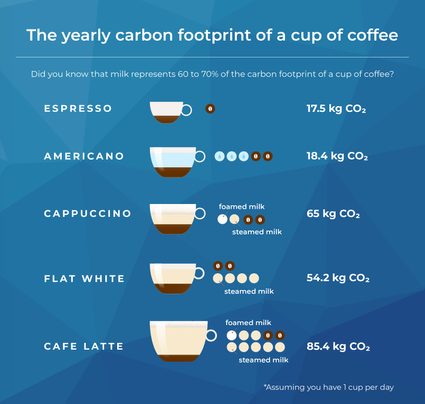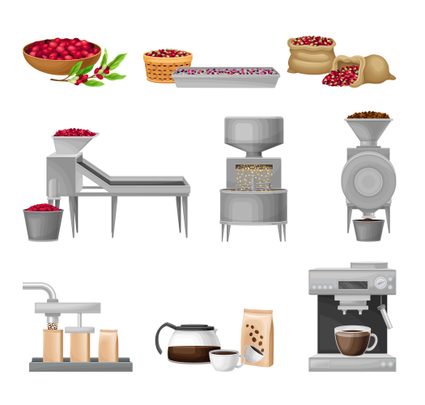Coffee Footprint Calculator
Whenever we need to pull an all-nighter, whether to complete a project or prepare for an exam, we find ourselves reaching out for our favorite aromatic drink, COFFEE.
Did you know that around 400 million cups of coffee are drunk every day in the United States?
And coffee is the second most traded commodity right after oil, which makes it one of the most valuable and luxury commodities. Moreover, on a global scale, the coffee shop/café is a $157 billion industry, that makes it feel worth it to celebrate International Coffee Day ☕ on October 1st.
Now not to make it sound heavy or anything, when we think about the environmental impact of coffee, we think about the giant pile of discarded, disposable cups, mounds of used coffee grounds, and non-recyclable coffee pods, but do we ever consider milk or water to be a cause of concern in making coffee? Do we ever consider the carbon footprint of the coffee we regularly drink? Worry not, as our coffee footprint calculator is here to the rescue and answers all your queries and concerns regarding your coffee's carbon footprint and sustainability.
🙋 On a related topic, you may also find our grams to tablespoons calculator helpful.
Should you be guilty of drinking coffee?
Biodegradable, sustainable, pollution-free, environmentally friendly, and reforestation might seem like just a few fancy words we come across in our daily routines, but for environmentalists and health experts, these are some of the major concerns. If predictions are correct and the production of coffee has to increase threefold by the middle of the century to meet the increasing consumer needs, then this is an alarming situation for forests because the land that is suitable to grow our beloved coffee trees is covered by forests.
You know what that means, right? We need to find more ways to make our products sustainable. Some of us might not be able to help on a production level, but we can at a consumption level.
Before we can take any action, we need to know how much our coffee-drinking habit is contributing to greenhouse gas emissions and calculate our coffee footprint using the coffee footprint calculator so that we can celebrate International Coffee Day with the satisfaction that we were able to make an environment-friendly contribution.

So, stay calm because you are not guilty of drinking coffee if you are opting for sustainable choices and making an effort to reduce your CO2 footprint.
How to use the coffee footprint calculator?
The coffee footprint calculator answers two very important questions:
- What is your actual coffee footprint?
- How to drink sustainably?
There are several types of coffees you can choose from:
- Espresso;
- Café late;
- Cappuccino;
- Flat white;
- Americano;
- Filter coffee;
- Canned coffee;
- Drip;
- Instant coffee; and
- French press.
To calculate the actual coffee footprint, you need to input your coffee consumption and choose it to be per day, per week, per month, or per year.
By ticking the Change coffee volume box, you can change the volume of your coffee, as the general calculations are based on the cup sizes of different types of coffee.
Once you have filled out all the data regarding your coffee intake, you can select the results to be displayed in a statistical manner of per week, per month, or per year.
The result is given as:
-
☕ Caffeine consumption.
-
💧 The amount of water utilized to produce your required amount of coffee:
- 🧍 Number of people that drink this amount of water.
-
👣 The amount of carbon dioxide equivalent produced:
- 🌳 Number of trees required to absorb the amount of carbon dioxide that is emitted.
-
How much this carbon dioxide is equal to in terms of different energy-consuming activities:
-
📱 Smartphones charged;
-
⛽ Liters of Gasoline consumed; and
-
🚗 Kilometers by an average vehicle.
-
To calculate how you can drink sustainable coffee, the input method for coffee consumption remains, as previously mentioned. You have to:
- Input the amount of coffee;
- The different types of coffee that you drink; and
- You still have the option to choose different volumes.
There are some questions that you can answer that will determine the sustainability of your choices based on what you would like to change about your coffee regimen.
- Use only reusable cups?
- Consider your milk use?
- Buy sustainable coffee?
You can choose different answers for these options based on what you can do and how willing you are to help, whether it is by changing some habits or changing your coffee intake.
As a result, you will see the difference between your actual coffee footprint and the sustainable choice you make. There are even more suggestions on how you can lower your CO2 footprint.
The world wants coffee!
The United States is the leading country in coffee consumption, where people drink 400 million cups of coffee every day, and it is the drink at 63%, followed by tap water at 47%.
That being said, the rest of the world isn't left behind in coffee consumption.
The table below shows an estimated coffee consumption per person in kilograms for the year 2020.
Country | Coffee per person |
|---|---|
Netherlands | 8.3 kg |
Finland | 7.8 kg |
Sweden | 7.6 kg |
Norway | 6.6 kg |
Canada | 5.5 kg |
Lebanon | 5.3 kg |
Germany | 5.2 kg |
Brazil | 5.1 kg |
Qatar | 5.0 kg |
Switzerland | 4.8 kg |
Have you ever noticed that your coffee-drinking friends are always on the go, ready to do the next task, and once they have had their coffee, they are a completely different person? That is because coffee fights depression and makes you feel happy.
🙋 If you're into cooking, why don't you try our grams to cups calculator?
What's the biggest culprit to your coffee footprint?
An estimate of is produced every year, and it doesn't stop there, as this production is growing exponentially and is forecasted to . This increases the pressure of production not only on the forests but also on the entire supply chain.

When you think about the environmental effects of coffee, do you ever consider the culprits other than the visual pollutants like paper cups and used coffee grounds? For instance, milk and water?
Milk makes up 60% to 70% of the carbon footprint for a cup of coffee.
By changing a few things, like how the coffee is grown, transported, and consumed, a significant drop of 77% in its carbon emission can be seen.
Although coffee has half the amount of carbon dioxide emission compared to the meat's footprint, it still goes as high as 15.33 kg of carbon dioxide for a single kilogram of green Arabica coffee when produced through conventional means.
Now only if the slightest change is made in growing this coffee sustainably, by using a lesser amount of chemical-based fertilizer, by efficiently managing the water and energy, and choosing cargo over airplanes for transportation, the carbon emission of the same coffee drops down to 3.51 kg of CO2 equivalent.
Did you know our favorite beverage, coffee, is among the things that prevent Alzheimer's disease? .
Coffee's water footprint
The amount of water we have on our planet may seem like a lot, yet we keep running into the same kind of talk every now and then about water scarcity.
, and much of the coffee's water footprint is the result of its bean cultivation.
The ideally suggested coffee-to-water ratio to make the perfect cup of coffee is said to be 1:17, meaning for 1 gram of coffee, use 17 grams of water.
🙋 You can swiftly convert units according to your needs with Omni's ml to grams calculator.
But that is just what you see and not the entire picture. To produce a regular cup of espresso, 1 part of coffee requires 1100 parts of water. And much of the water consumption is for bean cultivation.
Since it is a pressing issue, many companies and NGOs are coming together to work on the matter and come up with solutions that would not harm the environment, all the while meeting the increasing demand for coffee and other plants.
Coffee may be an energy-boosting drink for many of us when we are looking to stretch our limits a little more and maybe meet the deadline. But that is not all that coffee is meant for. There are many health benefits that come with a cup of this aromatic drink, which was sadly considered carcinogenic until 2016.
Sustainable and guilt-free cup of coffee
If every morning, you find yourself reaching for that beautifully aromatic cup of coffee, then friends, you are a coffee lover.
No need to panic, as we aren't gonna take you on a guilt trip and suggest you cut down your calories.
Simply make sustainable choices!
If you like milk in your coffee, try experimenting with a non-dairy option.
If you like to grab your coffee on the go, see if you can take your own reusable cups. That means a lot, as there are companies that are trying to make a change and reduce their disposable cups waste by requesting their customers to bring their own cups, which can reduce pollution by many folds.
If you happen to buy coffee in the seed-embedded coffee cups, make sure to find a place where you can grow them. Not sure what that means? You would be pleasantly surprised to know a company is making in them that, when sown, grow into a full tree.
Many coffee companies have also vowed to make a conscious effort to reduce their carbon footprint by sourcing coffee sustainably.
You would also be glad to know that :
- Caffeine;
- Riboflavin (vitamin B2);
- Magnesium and potassium; and
- Pantothenic acid (vitamin B5).
So, we will not stop you from drinking your favorite beverage; just suggesting a few sustainable ways to help our environment.
Regardless of what is known and shown on TV, scientists 👩🔬 and lab technicians are the ones who drink the highest amount of coffee among all the other professions, as the coffee kick is what they need to go the extra mile, just like everyone else.
FAQs
What creates the carbon footprint from coffee making?
Coffee bean cultivation, processing, and transport are the main reasons for carbon emissions from producing coffee.
Resources like water, agricultural lands, fertilizers, milk production, and energy are all needed to produce a simple cup of coffee.
How much water is needed to produce coffee?
According to the UN, around 140 liters of water is required to produce a cup of coffee. This number includes the cultivation of coffee beans, processing and transport.
What is the coffee footprint if I drink an espresso everyday?
Approximately 2.93 kg of CO₂ is emitted per month of drinking a cup of espresso every day. Apart from the carbon footprint, 4347 liters of water and forest lands, equivalent to 2 trees, are also needed to make 31 cups of espresso.
What can coffee grounds be used for?
Coffee grounds can be beneficial as an ingredient for composting, a natural body scrub, an insect repellent, or an odor neutralizer. In the biomass valorization industry, coffee grounds were also found to be a potential biofuel raw material and bioplastics composite.
How do I drink coffee sustainably?
You can follow these steps to make your coffee drinking more environmentally friendly:
-
Choose non-dairy options for your coffee.
-
Bring your own reusable cups, or support coffee shops that use biodegradable containers.
-
Buy coffee from local shops rather than imported products.
-
Support companies that produce coffee from sustainable sourcing.
-
Upcycle or recycle coffee wastes like coffee grounds and coffee capsules.